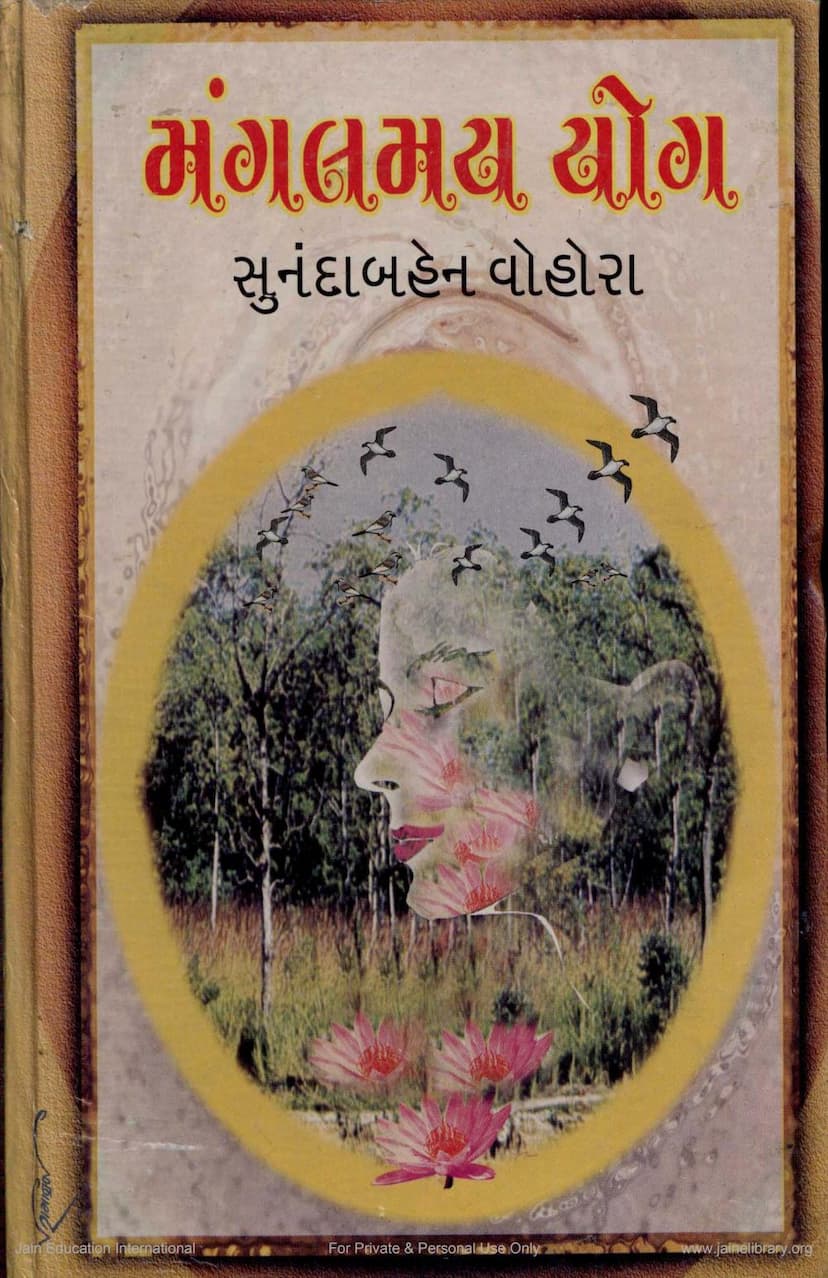Mangalmay Yog
Added to library: September 2, 2025

Summary
Here's a comprehensive summary of the Jain text "Mangalmay Yog" by Sunandaben Vohra, based on the provided pages:
Book Title: Mangalmay Yog (Prosperous/Auspicious Yoga) Author: Sunandaben Vohra Publisher: Gunanuragi Mitro (Friends of Virtue) Catalog Link: https://jainqq.org/explore/001992/1
Overall Theme:
The book "Mangalmay Yog" is a commentary and Gujarati translation of a foundational Jain text titled "Yogsar." Guided by the inspiration of Pujya Shri Bhadra Guptasuriji Maharaj Saheb, the work delves into the profound concept of "Yoga" within Jain philosophy. It emphasizes that true Yoga, in the Jain context, is not merely physical postures but a state of spiritual transformation leading to liberation (Moksha). The primary focus is on the development of inner purity, equanimity (Samata), and unwavering concentration on the self as the path to spiritual upliftment and ultimate freedom.
Key Concepts and Content:
-
The Nature of Yoga: The text defines Yoga as the union of the soul with the Supreme Soul, achieved through the transformation of the soul's inherent qualities. It is presented as a path to achieve liberation, achievable through various means like knowledge (Gyan), meditation (Dhyan), action (Kriya), and devotion (Bhakti). However, the book highlights the primacy of Gyan-Yoga (Yoga of Knowledge) due to the soul's inherent nature as knowledge itself.
-
The Goal of Yoga: The ultimate goal of Yoga, as explained, is Moksha (liberation from the cycle of birth and death). This is achieved by overcoming afflictions (Kashayas), desires (Vishaya), and ultimately, by attaining a state of pure, untainted consciousness. The text stresses that a life free from passions and attachments is essential for achieving this ultimate aim.
-
The Inner Journey: The book emphasizes that true Yoga is an internal process. It's about understanding the distinction between the body and the soul, achieving equanimity in all situations (whether favorable or unfavorable), and striving for a state of detachment from material pursuits. The true Yogi is characterized by their inner peace and stability, irrespective of external circumstances.
-
The Importance of Equanimity (Samata): Equanimity is presented as the cornerstone of spiritual progress. It's the ability to remain balanced and composed in the face of pleasure and pain, gain and loss, praise and blame. This equanimity arises from deep understanding and detachment.
-
Overcoming Passions (Kashayas): The text identifies the four primary passions – Krodh (anger), Maan (pride), Maya (deceit), and Lobh (greed) – as the primary obstacles on the path to liberation. It explains how these passions lead to suffering and hinder spiritual growth.
-
The Role of Knowledge and Right Conduct: The book champions the path of Samya-Gyan (Right Knowledge) and Samya-Charitra (Right Conduct) as the means to destroy karmas and achieve the soul's innate purity. It explains how shedding ignorance and attachment through right perception and action leads to spiritual purification.
-
The Union with the Divine: The text describes the ultimate union with the Supreme Soul (Paramatma) as the essence of Yoga. This union is realized when the soul, through self-awareness and pure contemplation, directly experiences its own true nature, which is inherently pure and blissful.
-
Analogy of the Crystal: The soul's pure nature is compared to a flawless crystal, which, though inherently pure, can appear colored due to external influences (like surrounding flowers). Similarly, the soul's pure state is obscured by karmas and passions. However, through practice and detachment, the soul can shed these obscurations and realize its pristine nature.
-
The Path of Virtues: The text highlights the importance of virtues like Kshama (forgiveness), Mardav (humility), Saralta (simplicity), Nirlobhta (non-greed), Tapas (austerity), Sanyam (restraint), Satyavachan (truthfulness), Shaucha (purity), Aparigraha (non-possession), and Brahmacharya (celibacy). These are presented as the "ten vows of a Muni" (Yati Dharma) which, when practiced diligently, help overcome passions and lead to the realization of the Supreme Soul.
-
The Danger of Self-Conceit and External Rituals: The book cautions against relying solely on external rituals or intellectual knowledge without inner transformation. It states that pride in one's own sect, scriptures, or perceived spiritual achievements without genuine inner purification is futile and leads to spiritual downfall. True spirituality lies in the purification of the mind.
-
The Essence of Dharma: The text reiterates that the core of all Dharma is Samata (equanimity and impartiality). It asserts that without this inner state, even intense external practices like austerities or fasts are meaningless. The essence of Dharma is the cultivation of a pure, balanced, and virtuous mind.
-
The Path of the Yogi: The book describes the Yogi's journey as one of constant vigilance and control over the mind, speech, and body. It emphasizes the destruction of internal enemies like attachment, anger, pride, deceit, and greed, and the cultivation of virtues like contentment, purity, and mindfulness.
In Essence:
"Mangalmay Yog" is a guide to understanding and practicing Yoga in its true Jain spiritual sense. It moves beyond mere physical exercises to present a comprehensive path of inner purification, self-discipline, and knowledge acquisition. By shedding attachments, controlling passions, and cultivating virtues, the individual can realize their true, pure, and blissful soul, ultimately achieving liberation. The book encourages a life of equanimity, detachment, and sincere spiritual practice, emphasizing that the true essence of Yoga lies in the unwavering pursuit of self-realization and freedom from worldly suffering.